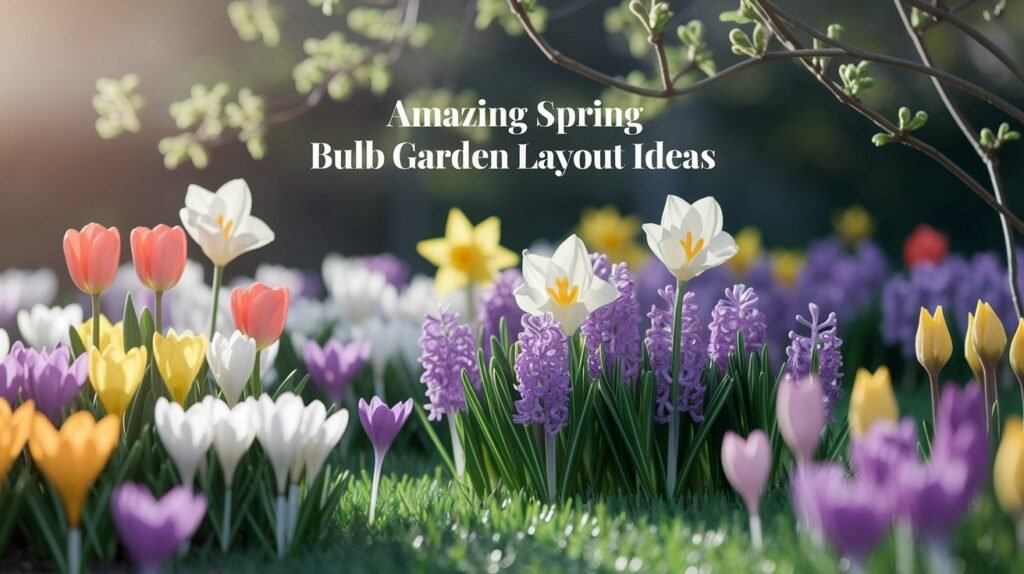Spring bulb gardening offers one of the most rewarding ways to transform your outdoor space into a vibrant seasonal display.
With thoughtful planning and strategic layouts, you can turn an ordinary yard into a breathtaking spring showcase that welcomes the warmer months with color and life.
The key to successful spring bulb gardens lies in understanding how different varieties work together to create visual impact.
Tulips provide bold, cup-shaped blooms in countless colors, while daffodils offer cheerful yellow and white flowers that naturalize beautifully.
Grape hyacinths add dense clusters of tiny purple or blue flowers, and alliums contribute striking spherical blooms that create vertical interest.
By combining these bulbs with intentional placement and creative arrangements, you can design a garden that offers continuous color from early spring through late spring, creating a foundation for your entire growing season.
List of 13 Spring Bulb Garden Layout
Creative arrangement strategies to maximize your spring bulb garden’s visual impact using color, height, timing, and strategic placement techniques.
1. Color Pockets Between Perennials
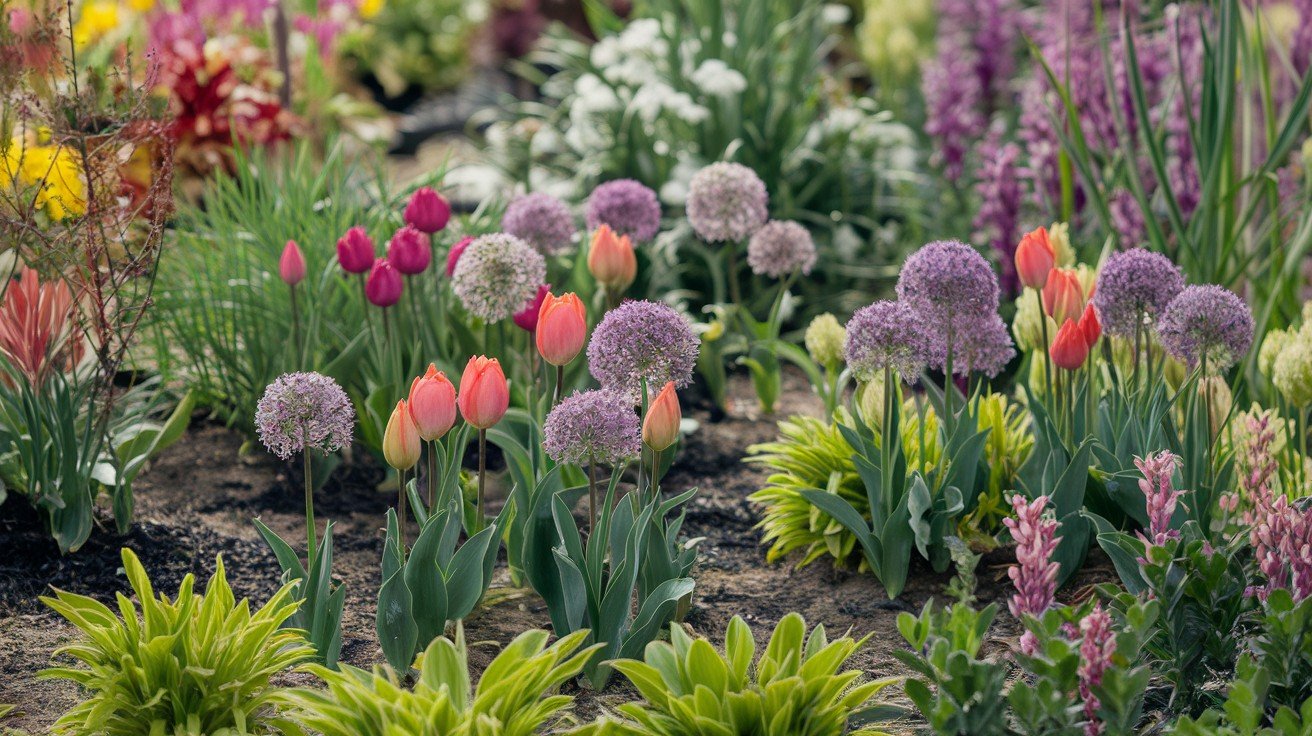
Create vibrant focal points by planting spring bulbs in the gaps between your established perennials.
Tulips and alliums work exceptionally well for this purpose, as their bold colors and distinct shapes provide striking contrast against emerging perennial foliage.
Group bulbs in clusters of 5-7 rather than scattering them individually for maximum visual impact. \
This approach allows you to add seasonal color to existing garden beds without major redesign while ensuring the bulbs make a strong statement rather than getting lost among other plants.
2. Paint With Color Combos
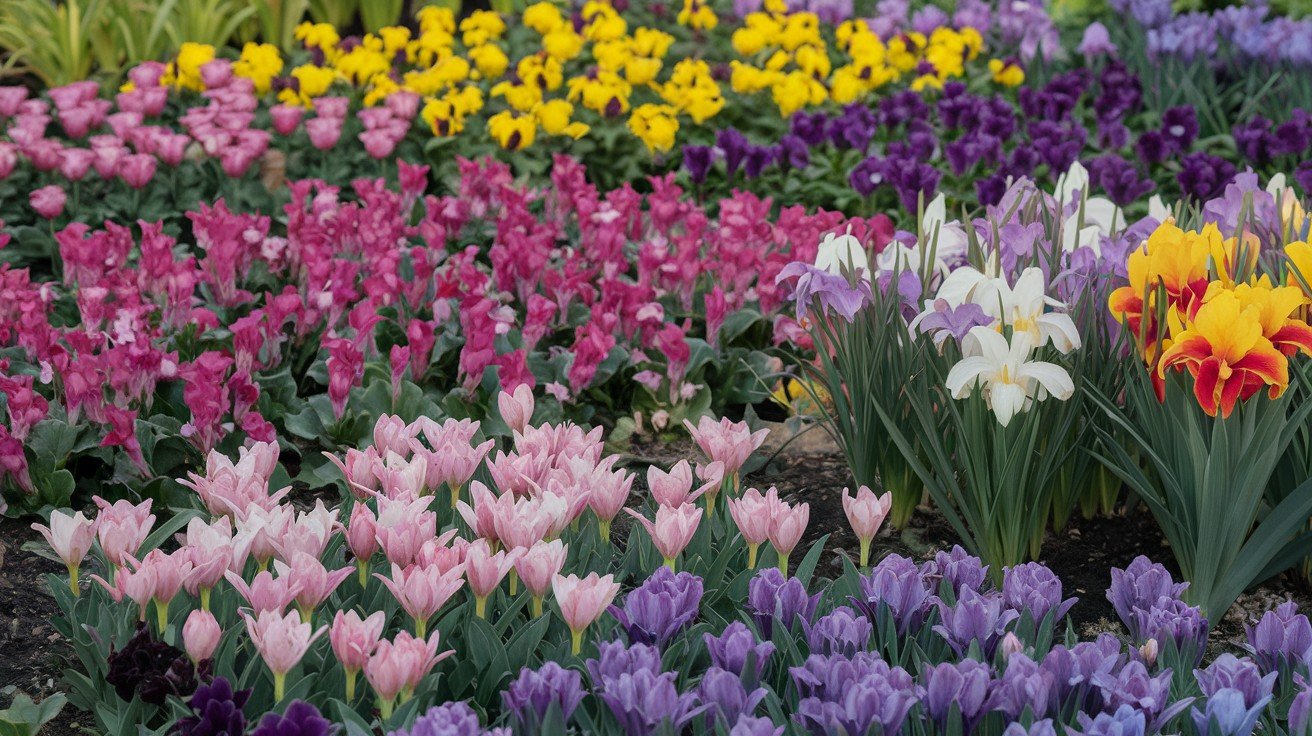
Convert your garden into an artistic masterpiece by using strategic color combinations that create visual harmony or dramatic contrast.
Pre-mixed bulb collections take the guesswork out of pairing compatible varieties, offering professionally curated combinations that bloom simultaneously.
For those who prefer to create their own schemes, consider monochromatic themes using different shades of the same color, or try contrasting combinations like purple and yellow, or orange and blue.
These intentional color relationships create sophisticated displays that feel cohesive and professionally designed.
3. Go Bold with Mass Plantings
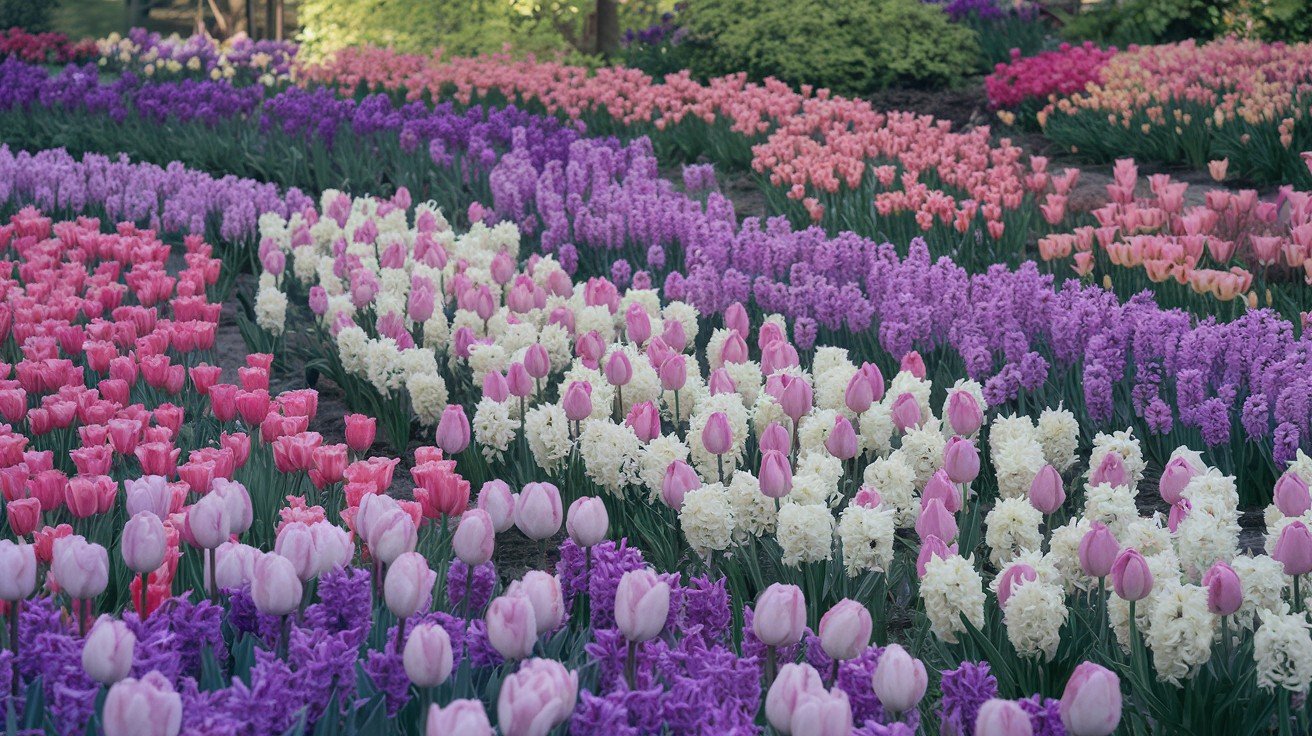
Make a dramatic statement by filling entire beds with simple, impactful color schemes using hundreds of bulbs in coordinated colors.
This approach works best when you follow the natural curves and shapes of your garden beds rather than forcing geometric patterns.
Choose 2-3 complementary colors and plant them in flowing drifts that mirror your landscape’s natural contours.
Mass plantings create the kind of breathtaking displays you see in famous public gardens, transforming ordinary spaces into spectacular seasonal showcases.
4. Blend Bulbs with Early Perennials
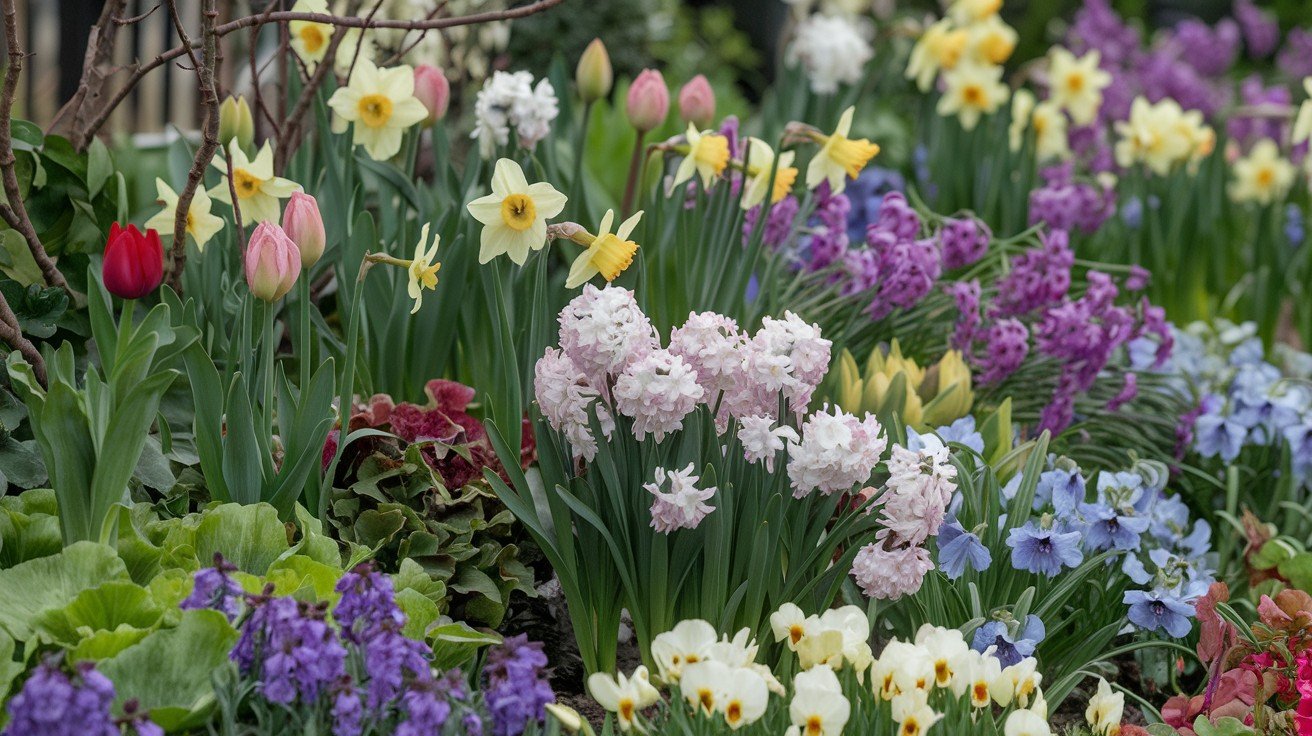
Combine spring bulbs with early-blooming perennials like pansies, creeping phlox, or hellebores to create layered displays that offer extended interest and varied textures.
This combination provides a smooth transition from spring bulbs to summer perennials while adding depth and complexity to your garden composition.
The perennials often bloom alongside or just after the bulbs, creating a natural progression that keeps your garden interesting throughout the changing seasons.
5. Disguise Dying Foliage with Perennials
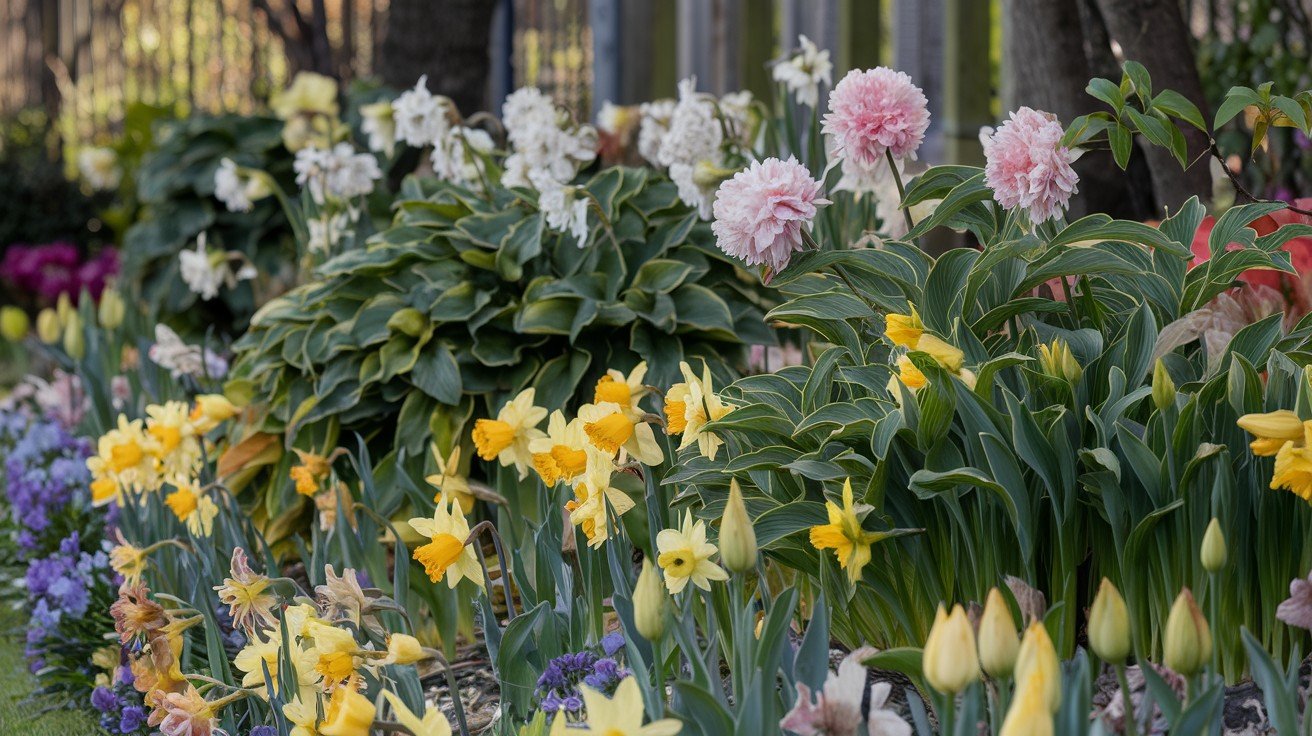
Address the challenge of yellowing bulb foliage by strategically planting perennials like hostas or peonies that will grow up and naturally cover the declining bulb leaves.
This technique keeps your garden looking tidy and attractive even as the bulbs complete their growth cycle.
The emerging perennial foliage provides a fresh, green backdrop that transitions your garden from spring blooms to summer growth, maintaining visual appeal throughout the growing season.
6. Create a Naturalized Bulb Meadow
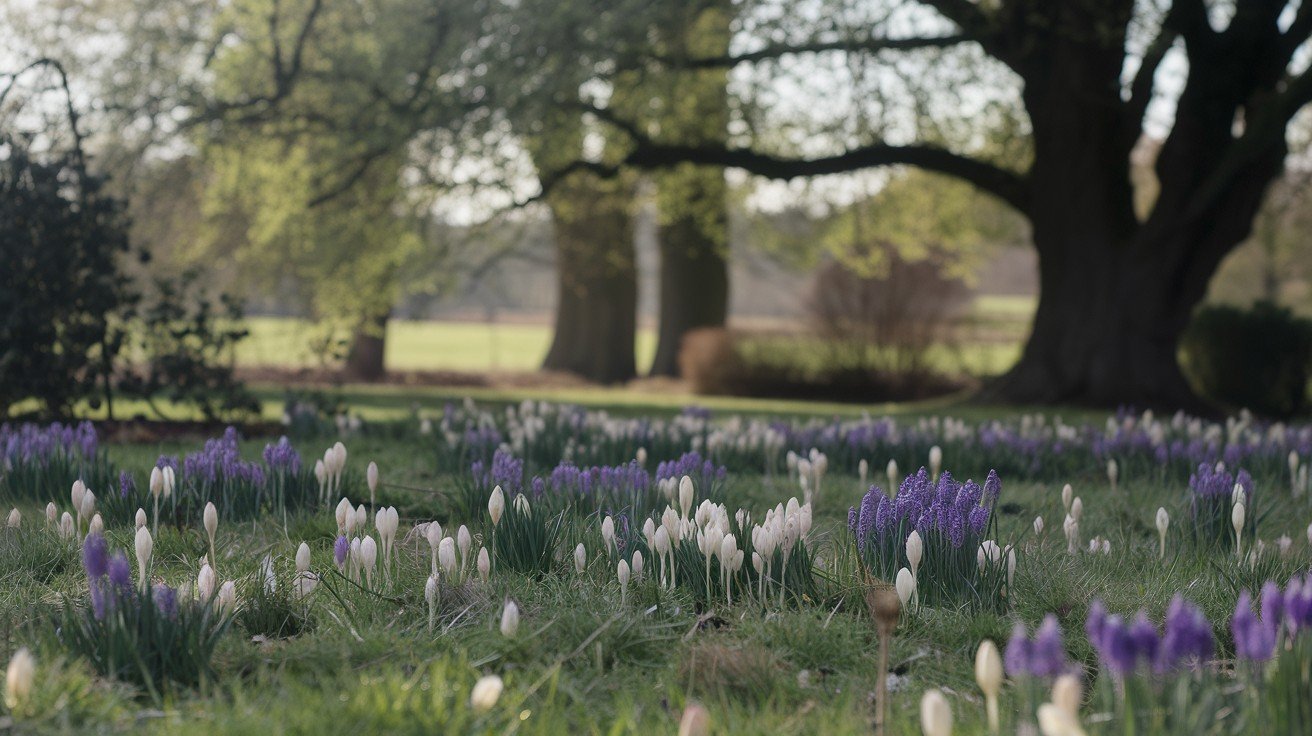
Establish a natural-looking meadow effect by scattering small bulbs like crocus, grape hyacinths, and squill throughout lawn areas or under trees.
This approach works particularly well in low-traffic areas where you can allow the bulbs to naturalize and multiply over time.
The random, organic placement mimics how bulbs would grow in nature, creating a charming, cottage-garden feel that requires minimal maintenance once established.
7. Build a Layered Bulb Bouquet Bed
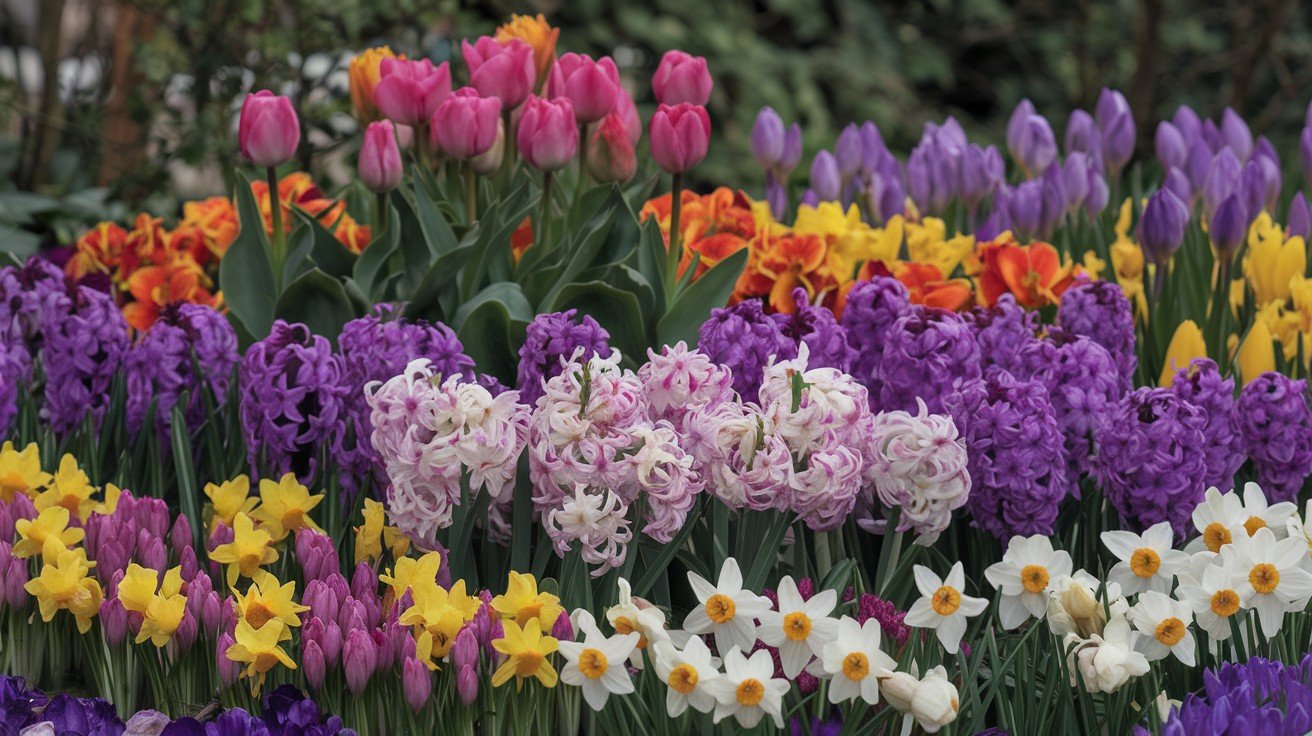
Create continuous blooms by planting bulbs at different depths in the same area, with larger bulbs like tulips planted deepest and smaller bulbs like hyacinths placed closer to the surface.
This technique maximizes space efficiency while providing multiple layers of color and texture.
As the deeper bulbs finish blooming, the shallow ones continue the display, creating a natural succession of flowers that extends your garden’s peak season.
8. Plan for Staggered Bloom Times
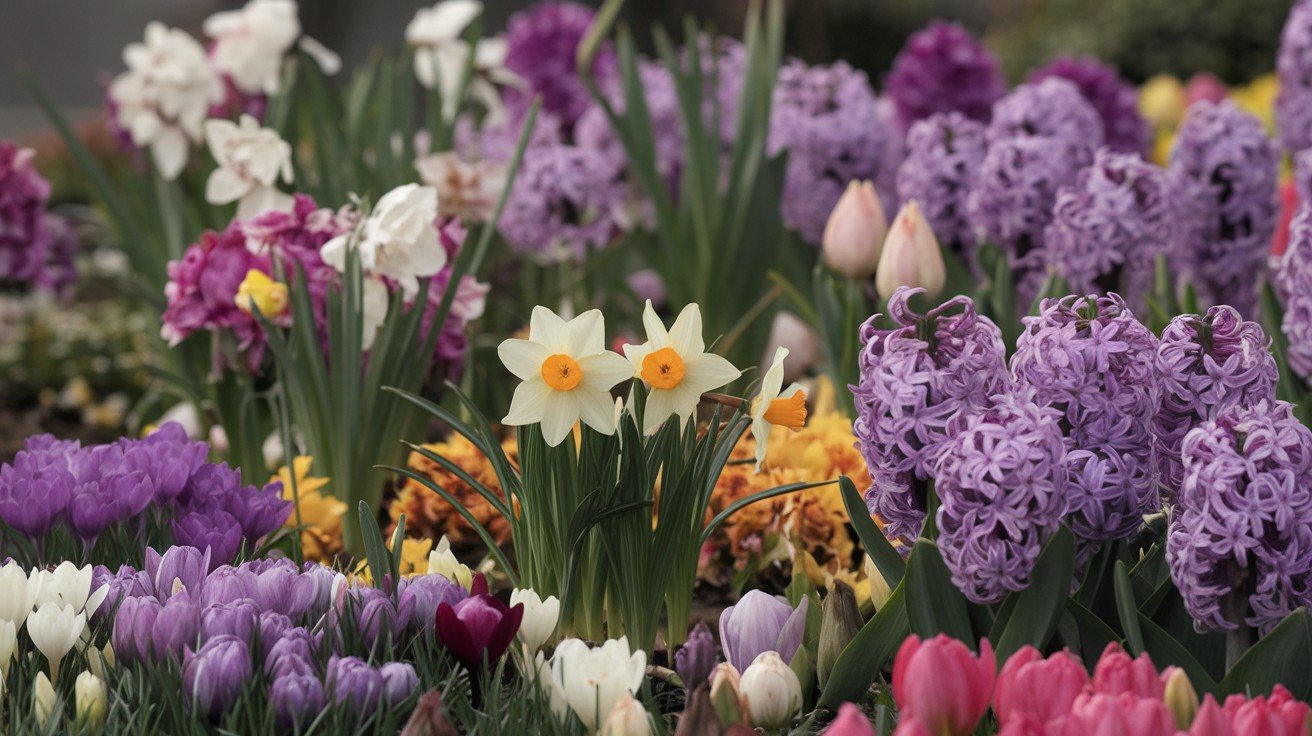
Extend your spring display by selecting bulbs with different bloom times, mixing early, mid, and late spring varieties in the same planting area.
For example, plant three different daffodil varieties that bloom in sequence to maintain continuous color for several weeks.
This approach ensures your garden never has a gap in blooms and provides consistent visual interest throughout the entire spring season.
9. Feature Foliage as a Design Element
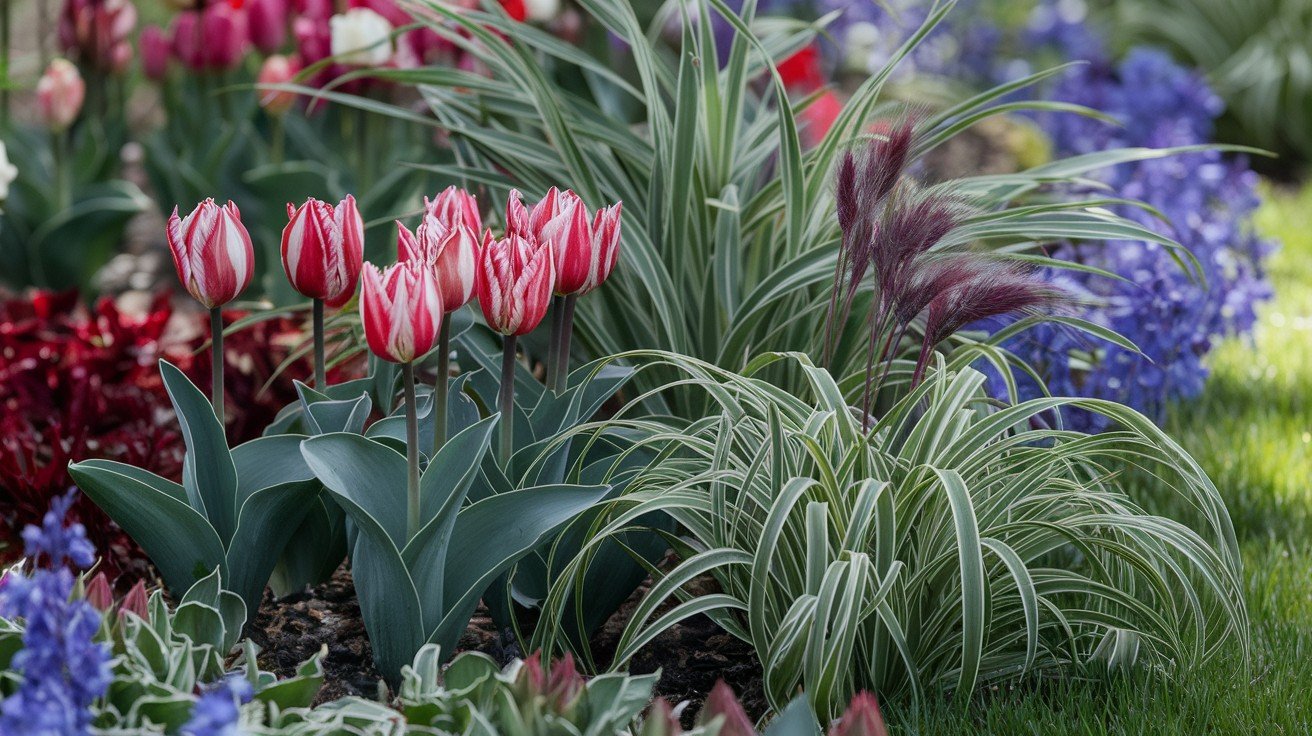
Choose bulb varieties that offer attractive foliage in addition to beautiful flowers, treating the leaves as an important design element rather than just something to hide.
Varieties like ‘Red Riding Hood’ tulips with their striped leaves, or Camassia ‘Blue Melody’ with its grass-like foliage, provide additional visual interest beyond their blooms.
This approach creates more sophisticated compositions that maintain appeal even when flowers fade.
10. Fill Bare Spots from Late-Rising Perennials

Use spring bulbs to provide early season color in areas where perennials like butterfly weed or hibiscus won’t emerge until late spring or early summer.
This technique ensures your garden beds never look empty or dormant, providing continuous coverage and color from early spring through summer.
The bulbs complete their growth cycle just as the perennials begin to fill in, creating perfect timing for seasonal transitions.
11. Showcase Special and Uncommon Bulbs
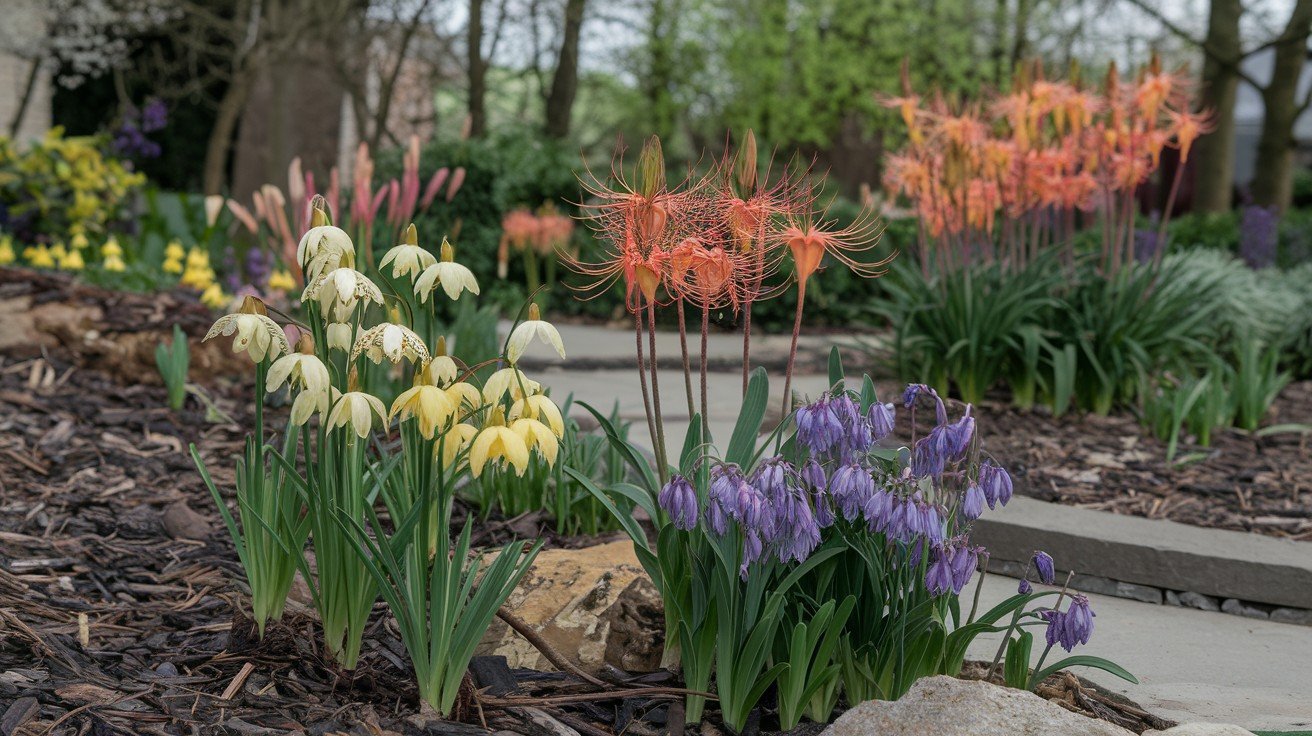
Create conversation pieces by incorporating unusual bulb varieties like fritillaria, foxtail lily, or camassia in prominent locations such as garden edges, walkways, or near seating areas.
These distinctive bulbs offer unique colors, shapes, or growth habits that set your garden apart from typical spring displays.
Their unusual characteristics make them perfect focal points that draw attention and spark interest among garden visitors.
12. Pot Up a Portable Bulb Garden
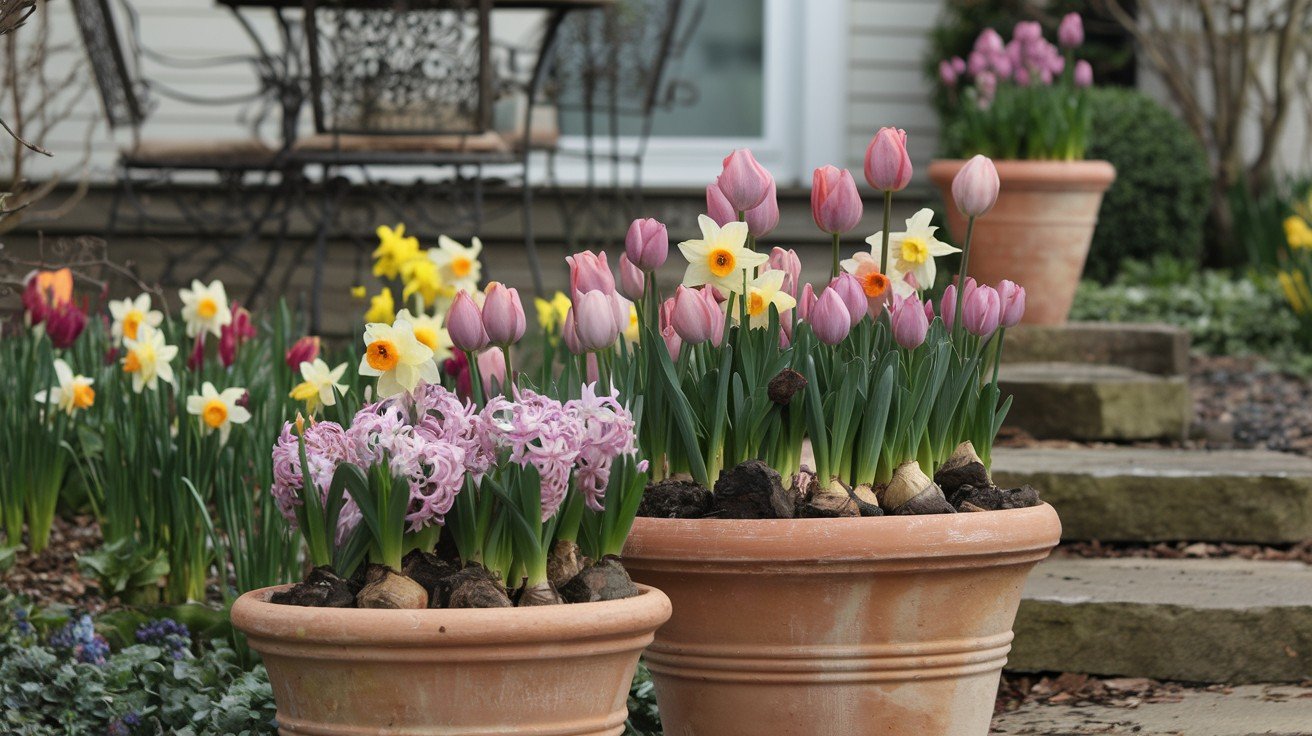
Design flexible displays using terracotta containers that can be moved around your garden or patio as needed.
Layer different bulb varieties in the same container, with tulips, daffodils, and hyacinths planted at appropriate depths to create succession blooms.
This approach allows you to position peak displays exactly where you want them most, whether that’s near entryways, on patios, or in areas that need temporary color boosts.
13. Design Around a Garden Feature

Frame existing garden features like birdbaths, arbors, or specimen trees with coordinated bulb plantings that complement and highlight these focal points.
Create symmetrical arrangements for formal gardens or flowing, curved plantings for more natural settings.
This technique integrates your bulb displays with existing hardscape elements, creating cohesive designs that feel intentional and professionally planned rather than randomly placed.
Conclusion
Spring bulb gardening offers rewards that multiply year after year, making it one of the most satisfying investments you can make in your outdoor space.
Start with a small color pocket between existing perennials, or go bold with mass plantings that transform entire beds, both approaches will bring you joy each spring as the bulbs return with renewed vigor.
For successful results, focus on proper planting techniques, adequate watering during establishment, and strategic layering that maximizes your garden’s potential.
Consider bookmarking your favorite layout ideas or printing these plans to reference during fall planting season, when bulbs are readily available and the ground is perfect for preparation.
With thoughtful planning and creative placement, your spring bulb garden will become a source of annual anticipation and seasonal celebration that grows more beautiful with each passing year.
Frequently Asked Questions
When is the best time to plant spring bulbs?
Plant spring bulbs in fall, typically 6-8 weeks before the ground freezes hard. This timing allows the bulbs to establish roots before winter dormancy and ensures proper cold treatment for spring blooming.
How deep should I plant different types of spring bulbs?
Plant bulbs at a depth three times their height – large tulips go 6-8 inches deep, while small crocus only need 3-4 inches. Proper depth protects bulbs from temperature fluctuations and provides adequate root development space.
Can I plant spring bulbs in containers?
Yes, containers work well for spring bulbs and offer flexibility in placement and design. Use pots at least 6-8 inches deep with drainage holes, and consider moving containers to protected areas during extreme cold.
How do I hide yellowing bulb foliage after blooming?
Plant companion perennials like hostas or peonies that will grow up and naturally cover declining bulb leaves. Never cut foliage until it turns completely yellow, as green leaves provide energy for next year’s blooms.
Do spring bulbs come back every year?
Most spring bulbs are perennials that return annually, often multiplying over time to create larger displays. Some varieties like tulips may decline after a few years, while daffodils and crocus typically naturalize and spread reliably.

